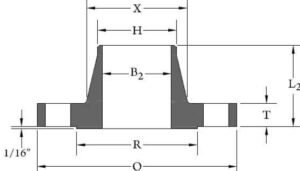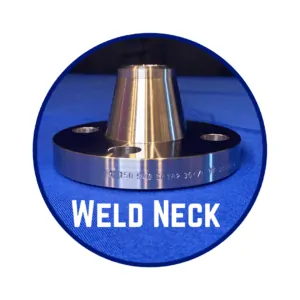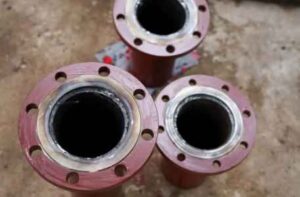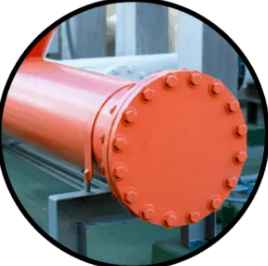Flanges play a vital role in connecting pipes, valves, and other equipment in industrial piping systems. Among the various standards governing flanges, ANSI (American National Standards Institute) flanges hold a prominent position. ANSI flanges are known for their uniformity, reliability, and compatibility, making them a preferred choice in multiple industries. In this article, we will explore five different types of ANSI flanges and discuss the distinction between ANSI and ASME flanges.
Image Source: Texas Flange
Weld Neck Flanges
Weld Neck Flanges, recognizable by their long tapered neck, are a popular choice for high-pressure applications. The tapered neck, which is welded to the pipe, provides excellent strength and durability, making it ideal for critical situations. The smooth transition from the flange face to the pipe ensures minimal turbulence and pressure drop. Weld Neck Flanges are commonly used in the oil and gas, chemical, and petrochemical industries.
Image Source: Texas Flange
Slip-On Flanges
Slip-On Flanges offer easy installation and are typically used in low-pressure applications. These flanges have a flat face and a slightly larger diameter than the pipe, allowing them to slip over the pipe end and then be welded in place. They are commonly found in water supply systems, HVAC systems, and low-pressure gas pipelines.
Image Source: Texas Flange
Socket Weld Flanges
Socket Weld Flanges feature a recessed area that accommodates the pipe end, providing high strength and durability. They are well-suited for high-pressure and high-temperature applications. Socket Weld Flanges are prevalent in the oil and gas, chemical, and petrochemical industries, where they offer robust connections for critical systems.
Image Source: Texas Flange
Blind Flanges
Blind Flanges serve a unique purpose as they are solid discs used to block off the end of a pipe or valve. These flanges are ideal for applications requiring the closure of piping systems or for pressure testing. The key benefit of blind flanges is their ability to provide a tight seal, preventing leaks. They are commonly used in the oil and gas, chemical, and petrochemical industries, particularly when maintenance or inspection is required.
Image Source: Texas Flange
Threaded Flanges
Threaded Flanges have internal threads that allow them to be easily screwed onto the pipe, simplifying installation. These flanges are primarily used in low-pressure applications, where frequent dismantling and inspection are necessary. Their ease of use makes them a practical choice for various industries.
ANSI vs ASME Flanges
ANSI and ASME both play significant roles in standardizing flanges, but they differ in their objectives and functions:
ANSI (American National Standards Institute): ANSI is a U.S.-based organization established in 1918, primarily responsible for overseeing national standards and accreditation systems for various products, services, processes, systems, and personnel in the United States. ANSI doesn’t create its own standards but unifies and condenses existing standards for practical purposes. ANSI ensures the consistency and quality of standards for products and services. It collaborates with international entities to ensure global standards compliance.
ASME (American Society of Mechanical Engineers): ASME is one of the oldest standards-developing organizations, founded in 1880, with a focus on mechanical requirements for pressure vessel equipment. ASME develops specifications that ANSI reviews. ASME standards are widely adopted in various industries, making them prevalent in the marketplace.
Frequently Asked Questions (FAQs):
What are ANSI flanges, and why are they important in industrial piping systems?
ANSI flanges are components that connect pipes, valves, and equipment in industrial piping systems. They are essential for creating reliable connections in various industries.
What are the primary types of ANSI flanges, and how do they differ?
ANSI flanges come in various types, including Weld Neck, Slip-On, Socket Weld, Blind, and Threaded flanges. They differ in design, installation method, and ideal applications.
When should I use Weld Neck Flanges in my piping system?
Weld Neck Flanges are ideal for high-pressure applications due to their tapered neck and welded connection, making them suitable for industries like oil and gas.
What are the advantages of using Slip-On Flanges?
Slip-On Flanges are easy to install and are well-suited for low-pressure applications. They are commonly used in water supply systems and HVAC setups.
In which industries are Socket Weld Flanges commonly employed, and why?
Socket Weld Flanges are frequently used in high-pressure and high-temperature conditions, making them popular in industries like oil and gas and chemicals.
How are Blind Flanges used in piping systems, and what makes them beneficial?
Blind Flanges are used to close off the end of a pipe or valve and can also be used for pressure testing. They provide a secure seal, preventing leaks.
What are the key features of Threaded Flanges, and where are they typically used?
Threaded Flanges have internal threads for easy installation and are commonly used in low-pressure applications where frequent disassembly and inspection are necessary.
What is the role of ANSI in standardizing flanges?
ANSI (American National Standards Institute) unifies and condenses existing standards, ensuring quality and consistency in products and services worldwide.
What does ASME (American Society of Mechanical Engineers) contribute to the standardization of flanges?
ASME creates standards, particularly for pressure vessel equipment, which are then reviewed and evaluated by ANSI. These standards are widely used in various industries.
What are the considerations for choosing the right type of ANSI flange for a project?
It is essential to consider factors like pipe size, pressure rating, material, facing type, flange type, and dimensions for selecting the appropriate ANSI flange.
How do I determine the correct size of an ANSI flange for my project?
Measure the outside diameter of the pipe the flange will be installed on, ensuring it matches the flange’s size requirements.
What is the pressure rating, and why is it important when selecting ANSI flanges?
Pressure rating indicates the maximum pressure a flange can withstand without failure. Choosing the right pressure rating is crucial for safety and performance.
What facing types are available for ANSI flanges, and how do they affect performance?
Common facing types include raised face (RF), flat face (FF), and ring-type joint (RTJ), which influence the sealing method. Choose the facing type according to your project’s application.
Can ANSI flanges be used in various industries other than the ones mentioned in the article?
Yes, ANSI flanges are versatile and find applications in a wide range of industries, such as power generation, water treatment, and more.
What safety and compliance benefits do ANSI and ASME standards provide for ANSI flanges in industrial settings?
ANSI and ASME standards ensure the quality, safety, and reliability of ANSI flanges, reducing the risk of accidents, failures, and costly downtime in industrial piping systems.
Conclusion
In summary, ANSI flanges offer a diverse range of connections, catering to different applications across industries. Weld Neck, Slip-On, Socket Weld, Blind, and Threaded flanges each have their unique features and advantages, allowing engineers and professionals to choose the most suitable option for their specific needs.
Understanding the difference between ANSI and ASME is also important. ANSI ensures the unification of standards and compliance for products and services, while ASME develops standards, especially for pressure vessel equipment. Both organizations have their place in the industry, contributing to the safety and quality of flanges and related components.
For more in-depth information on ANSI Flanges, consider exploring the following resources:
https://www.texasflange.com/products/flange-dims-weights/ansi-b16-5-forged-flanges/
https://www.texasflange.com/blog/difference-between-ansi-and-asme/





